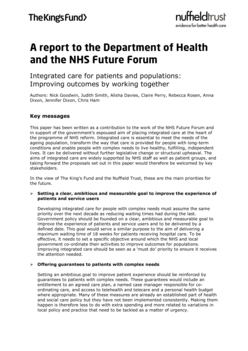Hello! You're looking at a policy document report on Overton
We track government policy, guidelines, think tank research, working papers and more to help our customers see the impact and influence of their work. Are you interested in seeing what information we have to offer? Request a free trial to our platform.
If you fund, produce or manage research or work to influence policy, we'd love to talk. Learn more on our homepage.

Identifiers
Overton ID
kingsfund-f1d32f2d0dfc94ac1facdd6193abc8e7
Integrated care for patients and populations: Improving outcomes by working together
Jennifer Dixon, Nick Goodwin, Alisha Davies, Rebecca Rosen, Professor Sir Chris Ham, Judith Smith, Anna Dixon and Claire Perry
This report from The King's Fund and Nuffield Trust is intended to support the Department of Health's development of a national strategy on integrated health and social care.
Topics in this document
General practice
Health care
Health care quality
Hospital
National Health Service
Patient
Payment by Results
Social work
National Health Service (England)
Health economics
Human activities
Goal
Monitor (NHS)
Department of Health and Social Care
Caregiver
Health
Evaluation
Health and Social Care Act 2012
NHS England
Preventive healthcare
Chronic condition
Primary care
NHS foundation trust
Public sphere
Health sciences
Electronic health record
Risk
Disease
Governance
Medicine
Related SDGs
SDG 3: Good Health and Well-being ...
SDG 3: Good Health and Well-being
Target 3.8
Achieve universal health coverage, including financial risk protection, access to quality essential health-care services and access to safe, effective, quality and affordable essential medicines and vaccines for all
Cites research funded by
Citations
Cited by 24
other policy documents
(16 of them are from other policy sources)
